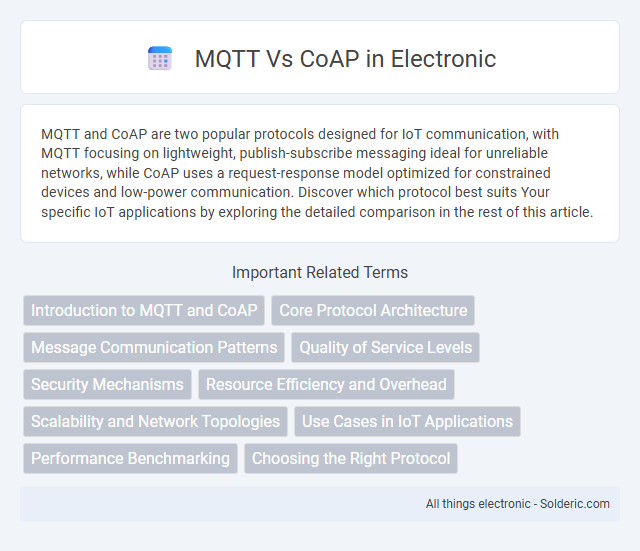MQTT and CoAP are two popular protocols designed for IoT communication, with MQTT focusing on lightweight, publish-subscribe messaging ideal for unreliable networks, while CoAP uses a request-response model optimized for constrained devices and low-power communication. Discover which protocol best suits Your specific IoT applications by exploring the detailed comparison in the rest of this article.
Comparison Table
| Feature | MQTT | CoAP |
|---|---|---|
| Protocol Type | Publish/Subscribe Messaging | Request/Response (RESTful) |
| Transport Layer | TCP/IP | UDP/IP |
| Use Case | IoT telemetry, real-time messaging | Constrained devices, low-power networks |
| Message Size | Small to Medium | Very Small (Lightweight) |
| Quality of Service (QoS) | 0, 1, 2 (At most once to exactly once delivery) | Confirmable, Non-confirmable |
| Security | TLS/SSL encryption | DTLS encryption |
| Broker | Required (Centralized server) | Not required (Peer-to-peer) |
| Header Size | Variable (2 bytes minimum) | Fixed (4 bytes) |
| Standardization | OASIS Standard | IETF RFC 7252 |
Introduction to MQTT and CoAP
MQTT is a lightweight messaging protocol designed for efficient communication in constrained devices and low-bandwidth networks, using a publish-subscribe model ideal for IoT applications. CoAP (Constrained Application Protocol) is a web transfer protocol optimized for resource-constrained devices, enabling RESTful communication using UDP and supporting multicast. Your choice between MQTT and CoAP depends on the network environment, device capabilities, and application requirements for reliable or real-time data exchange.
Core Protocol Architecture
MQTT operates on a lightweight publish-subscribe architecture designed for efficient message distribution over TCP/IP, ideal for reliable, real-time communication in constrained networks. In contrast, CoAP uses a request-response model built on UDP, emphasizing simplicity and low overhead for stateless interactions in resource-constrained IoT environments. Understanding the core protocol architecture helps you select the most suitable protocol for your IoT application's communication needs and network conditions.
Message Communication Patterns
MQTT primarily supports a publish-subscribe communication pattern, enabling efficient one-to-many message distribution through topics managed by a broker, which reduces network bandwidth and simplifies device communication. CoAP uses a request-response communication pattern similar to HTTP, with support for multicast messaging, allowing direct client-server interactions and efficient group communication in constrained IoT networks. These distinct patterns make MQTT ideal for scenarios requiring asynchronous, real-time updates, while CoAP suits resource-constrained environments needing simple, reliable request-response exchanges.
Quality of Service Levels
MQTT offers three Quality of Service (QoS) levels--QoS 0 (at most once), QoS 1 (at least once), and QoS 2 (exactly once)--ensuring flexible message delivery guarantees tailored to network conditions and application needs. CoAP primarily supports a simpler reliability model with confirmable and non-confirmable messages, providing basic assured delivery without the granular QoS levels of MQTT. Choosing MQTT's QoS levels enhances Your control over message delivery reliability in IoT environments with varying network quality.
Security Mechanisms
MQTT employs username/password authentication and supports SSL/TLS encryption for secure data transmission, ensuring confidentiality and integrity over TCP/IP networks. CoAP integrates Datagram Transport Layer Security (DTLS) to provide security over UDP, facilitating encrypted communication and endpoint authentication suitable for constrained environments. Both protocols implement mechanisms to prevent unauthorized access, but MQTT's reliance on TCP and TLS offers more robust transport-level security compared to CoAP's lightweight DTLS approach.
Resource Efficiency and Overhead
MQTT uses a lightweight publish-subscribe protocol optimized for low bandwidth and minimal packet size, making it highly resource-efficient for constrained devices. CoAP operates over UDP with a request/response model, reducing overhead further by eliminating the need for persistent connections, which is beneficial for low-power networks. Both protocols are designed for efficient communication in IoT, but MQTT's minimal header size and persistent session features balance resource efficiency with reliable message delivery.
Scalability and Network Topologies
MQTT excels in scalability with its lightweight publish-subscribe model that supports thousands of devices across complex star and tree topologies. CoAP, designed for constrained environments, performs efficiently in mesh network topologies, facilitating device-to-device communication with multicast capabilities. Your choice depends on whether you prioritize MQTT's centralized broker scalability or CoAP's decentralized, resource-efficient mesh networking.
Use Cases in IoT Applications
MQTT excels in IoT applications requiring reliable, low-latency messaging such as remote monitoring, real-time data collection, and industrial automation due to its lightweight publish-subscribe protocol. CoAP is designed for constrained devices and networks, making it ideal for resource-limited environments like smart homes, environmental sensing, and building automation where efficient and simple request/response communication is crucial. Your choice between MQTT and CoAP should depend on factors like network reliability, device capabilities, and communication patterns specific to your IoT use case.
Performance Benchmarking
MQTT demonstrates lower latency and higher throughput in environments with limited bandwidth due to its lightweight publish-subscribe model, making it suitable for real-time applications. CoAP excels in constrained networks by using UDP, reducing overhead and enabling faster response times with minimized packet loss. Performance benchmarking reveals MQTT achieves consistent message delivery under varied network conditions, while CoAP offers superior efficiency in multicast scenarios and device-to-device communication.
Choosing the Right Protocol
Selecting the right protocol between MQTT and CoAP depends on the application's communication requirements and network conditions. MQTT excels in reliable, low-bandwidth, and publish-subscribe messaging for IoT devices with intermittent connectivity, while CoAP is optimized for constrained environments using request-response interactions over UDP. Consider factors such as latency sensitivity, energy consumption, and firewall traversal capabilities to determine the appropriate choice for your IoT deployment.
MQTT vs CoAP Infographic

 solderic.com
solderic.com